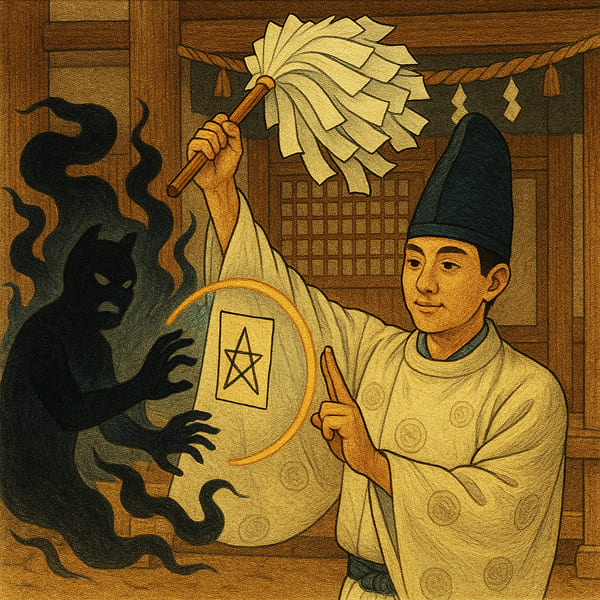Curse Reversal in Japanese Culture: How to Reflect Evil Back to Its Source

Contents
A cold shiver runs down your spine. A string of misfortunes that can’t be explained. A feeling that someone, somewhere, wishes you harm.
In Japan, such experiences might not be dismissed as coincidence—they could be signs of a curse.
Enter the ancient art of curse reversal (Juso-gaeshi, 呪詛返し)—a powerful spiritual practice that doesn’t just break a curse, but sends it back to its source. Deeply rooted in Shinto rituals, Onmyodo esoterica, and folk beliefs, juso-gaeshi is both a form of defense and a kind of spiritual justice.
In this article, we’ll uncover the origins, methods, and modern presence of this fascinating practice—from talismans and sacred rituals to its role in anime and contemporary spirituality. Discover how Japan’s mystical traditions empower people to protect themselves—and even turn the tables on unseen enemies.
What Is Curse Reversal in Japanese Belief?
Curse reversal refers to the act of reflecting a curse or malicious intent back to the individual who originally cast it. In Japanese folklore, it is believed that curses carry energy—energy that can be sent back to its source through proper spiritual means. Rather than simply breaking a curse, juso-gaeshi emphasizes retaliation and protection, punishing the wrongdoer while shielding the victim from ongoing harm.
This concept is often used when the origin of the curse is known or suspected. Reversing the curse is thought to restore spiritual balance, turning negative energy against its creator.
Traditional Methods of Curse Reversal
There are several culturally significant ways to reverse a curse in Japan, typically involving ritual practices, spiritual tools, or invocations. Common methods include:
-
Purification Rituals (Oharai)
Conducted at Shinto shrines or Buddhist temples, purification rituals are designed to cleanse the body, mind, and spirit. These ceremonies remove negative influences and are believed to redirect curses. Some forms of oharai can also be performed at home with the guidance of a priest or monk.
-
Protective Talismans (Ofuda)
An ofuda is a sacred amulet issued by shrines to offer spiritual protection. Placing an ofuda in one’s home or carrying it on the body is believed to ward off evil and reflect harmful energy. Some ofuda are specifically designed to counter curses and deflect negative spiritual forces.
-
Incantations and Chants (Jumon)
Spoken spells or chants, especially those rooted in Onmyodo, are used to invoke divine powers for curse reversal. These jumon are believed to carry protective force and can act as verbal shields against spiritual attacks. Proper chanting technique and intent are essential for effectiveness.
These practices are influenced by regional customs and the spiritual expertise of the practitioner. Regardless of the method, the goal remains the same: to turn evil energy away and neutralize its source.
Cultural and Religious Context
Curse reversal is closely tied to Japan's traditional views of spiritual balance, karma, and natural justice. In Shinto, purity and harmony are central themes, and rituals like oharai are meant to maintain this balance. Buddhism also contributes to the understanding of karmic retribution—what goes around comes around.
In this way, curse reversal is not just a supernatural practice but a moral one. It reflects the belief that ill intentions will inevitably return to their source, reinforcing accountability in spiritual matters.
Curse Reversal in Modern Japan
Though ritual curse reversal is less common today, the concept remains prevalent in modern Japanese culture. It often appears in anime, manga, and films as a form of spiritual justice. Characters frequently use spells, talismans, or incantations to fight back against curses, drawing from traditional beliefs.
Modern spiritual practitioners and fortune-tellers also offer curse reversal services, both in person and online. These include energy cleansing, psychic consultations, and customized rituals. The demand for such services reflects the enduring belief in unseen forces and the need for spiritual protection in contemporary life.
Conclusion: Spiritual Protection in Japanese Tradition
Curse reversal (Juso-gaeshi) is an enduring element of Japanese spiritual culture. From sacred rituals and talismans to powerful incantations, it offers a way to repel malicious energy and return it to its source. Rooted in folk beliefs, Shinto purification, and karmic principles, curse reversal continues to influence modern Japanese spirituality and storytelling. Whether for self-protection or symbolic justice, it remains a compelling and meaningful practice.